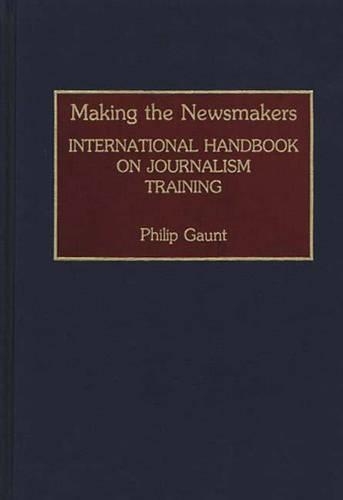
Making the Newsmakers: International Handbook on Journalism Training
(Hardback)
Publishing Details
Making the Newsmakers: International Handbook on Journalism Training
By (Author) Philip Gaunt
Bloomsbury Publishing PLC
Greenwood Press
24th August 1992
United States
Classifications
Tertiary Education
Non Fiction
Industrial or vocational training
Reference works
070.4
Physical Properties
Hardback
256
Width 156mm, Height 235mm
624g
Description
This study of journalism training analyses training programmes in 70 countries and lists 600 training institutions around the world. This worldwide survey of communication training since 1958 was sponsored by UNESCO. In analysing different programmes, the study examines such areas as the type of institution in which training is given, the kinds of courses offered, entrance requirements, the number of students, qualifications of educators, diplomas or degrees awarded and the placement of graduates. It also explores different press concepts as they relate to training and identifies the specific needs arising from each system. In particular, it notes the massive changes that have taken place in Eastern and Central Europe and speculates what kind of system will emerge in that region. After analysing the programme in the seven regions of the world, the study identifies the principal challenges facing communication training in both the developing world and the industrialised nations. It concludes that, while differences are likely to remain for a long time to come, there is at least the possibility that journalism and journalism training will become more homogeneous in the future. This volume, both a scholarly work and a directory, may become the standard reference on communication training.
Reviews
Specialists in nonjournalism areas who are interested in the problems of professional training in their field in different parts of the world may find this book useful as a prototype. Gaunt offers a chapter on the conflicting views of training of primarily newspaper journalists in the developed and developing worlds, which parallel the differing views toward guidance in other fields by government, industry, colleges, and technical institutes. The author next summarizes the differing basic assumptions of how journalists collect the news, saying that these approaches have to be agreed upon before training can be successful. He leaves in the air what should be taught and how. The rest of the book will be more useful to journalists: a country-by-country discussion of training approaches, followed by a lengthy address list. His discussion of Eastern Europe catches only the end of communism and not the newest restructuring of training programs. Gaunt provides the most complete report since the 1958 UNESCO classic, The Training of Journalists: A World-Wide Study on the Training of Personnel for the Mass Media (o.p.). Gaunt's handbook is essential for its current lists and useful for its country-by-country text, even though some countries are skipped. For academic journalism collections.-Library Journal
This book is a hitchhiker's guide to journalism education; an eminently readable, fascinating, and exhaustive compilation study that examines journalism and J-schools around the world. It should be required reading for foreign correspondents and bureau chiefs. For college professors, it can be a valuable resource of lecture material.-Quill
"This book is a hitchhiker's guide to journalism education; an eminently readable, fascinating, and exhaustive compilation study that examines journalism and J-schools around the world. It should be required reading for foreign correspondents and bureau chiefs. For college professors, it can be a valuable resource of lecture material."-Quill
"Specialists in nonjournalism areas who are interested in the problems of professional training in their field in different parts of the world may find this book useful as a prototype. Gaunt offers a chapter on the conflicting views of training of primarily newspaper journalists in the developed and developing worlds, which parallel the differing views toward guidance in other fields by government, industry, colleges, and technical institutes. The author next summarizes the differing basic assumptions of how journalists collect the news, saying that these approaches have to be agreed upon before training can be successful. He leaves in the air what should be taught and how. The rest of the book will be more useful to journalists: a country-by-country discussion of training approaches, followed by a lengthy address list. His discussion of Eastern Europe catches only the end of communism and not the newest restructuring of training programs. Gaunt provides the most complete report since the 1958 UNESCO classic, The Training of Journalists: A World-Wide Study on the Training of Personnel for the Mass Media (o.p.). Gaunt's handbook is essential for its current lists and useful for its country-by-country text, even though some countries are skipped. For academic journalism collections."-Library Journal
Author Bio
PHILIP GAUNT is Director of Research at the Elliott School of Communication, Wichita State University. He is the author of Choosing the News (Greenwood, 1990) as well as numerous articles in Journalism Quarterly, Media Culture and Society and other scholarly publications.
